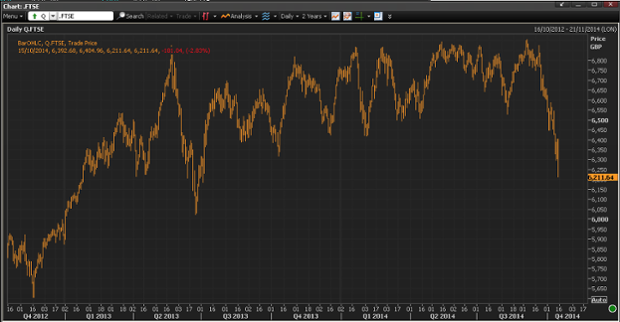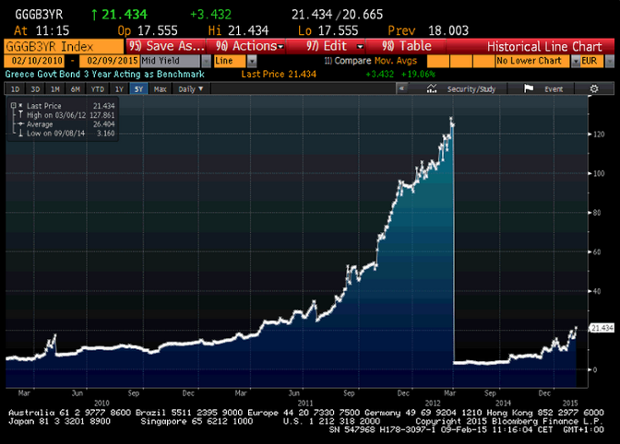Stocks Slide Most Since ’09 as TwoYear Yield Reaches Record Low Bloomberg Business
Post on: 31 Март, 2015 No Comment

Passersby are reflected on an electric board showing the Nikkei 225 index in Tokyo. Photographer: Shuji Kajiyama/AP
Aug. 4 (Bloomberg) — A global rout in equities drove the Standard & Poor’s 500 Index to its worst slump since February 2009, while two-year Treasury yields plunged to a record low amid concern the economy is weakening. The yen pared losses, recovering from the biggest drop versus the dollar since 2008 that was triggered by Japan selling its currency.
The S&P 500 tumbled 4.8 percent to 1,200.07 at 4 p.m. in New York with futures on the gauge slipping 0.2 percent as of 6:17 p.m. The S&P 500 has dropped 11 percent since July 22, the biggest loss over the same amount of time since March 2009. The MSCI All-Country World Index slid 4.1 percent as Brazil’s stocks slumped to a two-year low and Switzerland’s entered a bear market. Two-year yields declined as low as 0.25 percent. The yen sank 4.1 percent against the dollar before trimming its loss almost in half. Oil sank 5.8 percent to help the Thomson Reuters/Jefferies CRB Index of materials erase its 2011 gain.
Concern the global economy may relapse into a recession has driven investors out of stocks and into the relative safety of Treasuries, the Swiss franc and yen and is spurring speculation the Federal Reserve will start another stimulus program. Japan’s moves to sell the yen, which this week neared a post-World War II record, and expand an asset-purchase fund follows efforts by the Swiss central bank to curb the franc’s gains. The European Central Bank resumed bond purchases and offered banks more cash to stem the spread of the debt crisis.
‘Gloomy’
“The mood right now is gloomy,” Mike Ryan, the New York-based chief investment strategist at UBS Wealth Management Americas, said in a telephone interview. His firm oversees $774 billion. “The burden of proof is for better data that show the economy is not falling into recession. Tomorrow’s payroll report is crucial. If we see another disappointment, the stock market will have significant downside from here.”
Commerce Department data tomorrow may show U.S. employers added 85,000 jobs in July, according to the median economist estimate in a Bloomberg survey. In June, they added 18,000.
Today’s slide in the S&P 500 drove up the cost of using options to insure against further declines by the most since February 2007. The VIX, as the Chicago Board Options Exchange Volatility Index is known, jumped 35 percent to a 13-month high of 31.66.
Goldman Sachs Group Inc.’s Hedge Fund VIP basket, meant to track the 50 stocks most important to hedge funds, slid 6.8 percent for its worst plunge since Dec. 1, 2008, as Valeant Pharmaceuticals International Inc. Chemtura Corp. and LyondellBasell Industries NV lost more than 10 percent.
The 11 percent rout since July 22 dragged the S&P 500’s valuation to 13.2 times reported earnings, the cheapest level since the month the bull market began in 2009, according to data compiled by Bloomberg.
‘Very Bullish’
“We’re very bullish,” Barry Knapp, chief U.S. equity strategist at Barclays Plc in New York, said in an interview on Bloomberg Television. “To be clear, we think that the stock market represents exceptional value. The Treasury market represents exceptionally rich levels.”
Energy and raw-material producers lost more than 6.6 percent for the biggest slumps among 10 industries in the S&P 500, all of which sank more than 3 percent. Alcoa Inc. Caterpillar Inc. and Bank of America Corp. slid 7 percent or more to lead declines in all 30 stocks in the Dow Jones Industrial Average, which plunged 512.76 points, or 4.3 percent, to 11,383.68 in its biggest decline since Feb. 10, 2009, and joined the S&P 500 in wiping out its 2011 advance.
Gap Inc. the largest U.S. apparel chain, sank 12 percent after sales missed analysts’ estimates. DirecTV, the largest U.S. satellite-television provider, tumbled 5.7 percent after adding fewer U.S. customers than analysts estimated. Apple Inc. sank 3.9 percent and Exxon Mobil Corp. tumbled 5 percent in its biggest plunge since March 2009.
Not a ‘Flash Crash’
The S&P 500 moved in a 4.8 percentage-point range between today’s intraday high and low, the widest since the 20-minute “flash crash” on May 6, 2010, erased $862 billion from the value of U.S. shares before prices rebounded. Today’s swing was about triple the average range in the past four weeks. About 14 billion shares changed hands on all U.S. exchanges, the most in 14 months.
“It’s very, very, very different from the flash crash,” said Joseph Mazzella, global head of trading at Knight Capital Group Inc. in Jersey City, New Jersey. “There was more volume, more volatility and a vicious window where trading got disorderly that day. Today, relatively speaking, was an orderly sell-off. The market opened lower and it’s been grinding lower all day long.”
Short-Sale Curbs
Almost 850 securities triggered short-sale curbs today after declining at least 10 percent from their closing price yesterday, according to data compiled by Bloomberg. They limit bearish bets in those securities the day they’re triggered and the next, requiring traders to execute orders at prices higher than the best bid available in the market. The rule went into effect on Feb. 28. In the first four weeks they operated, only three days had more than 100 triggers, with no day registering more than 300.
Money market rates, which surged during the debate to raise the federal borrowing cap, dropped below zero percent as Europe’s sovereign-debt crisis bolstered U.S. government securities’ appeal as the world’s safest assets. U.S. 30-year mortgage rates plunged to the lowest level in more than eight months, sliding to 4.39 percent in the week ended today from 4.55 percent, according to Freddie Mac. The average 15-year fixed-loan rate decreased to a record 3.54 percent from 3.66 percent.
Safe Havens
Demand for short-term government debt instruments is rising as Treasury bills are expected to remain in short supply after the U.S. signaled yesterday it won’t increase sales of the securities even following lawmakers’ agreement to raise the debt ceiling.
Bank of New York Mellon Corp. the world’s largest custody bank, will charge institutional clients a fee for “extraordinarily high” cash deposits to stem a flight of capital into the safety of bank deposits.
“I’ve never seen this happen, not in 25 years,” Gerard Cassidy, an analyst with RBC Capital Markets in Portland, Maine, said in an interview. Other banks may follow BNY Mellon’s lead, he said.
The S&P 500 yesterday climbed 0.5 percent to snap a seven-day slump, recovering after the Wall Street Journal reported that former Fed officials Donald Kohn, Vincent Reinhart and Brian Madigan said the central bank should consider a third round of bond purchases to help the economy.
Political ‘Firestorm’
Speculation the Fed will start a third round of quantitative easing, or “QE3,” is increasing after U.S. data in the past week showed manufacturing grew at the weakest pace in two years, spending unexpectedly fell and service industries grew at the slowest pace since February 2010. The second round of bond purchases ended in June.
“Given that the last QE2 program just ended, it would be good to wait, because the impact of another program now is questionable,” Alfred Broaddus, former president of the Richmond Fed, said in a Bloomberg TV interview. “And of course, it would probably create something close to a firestorm of political criticism and criticism from market observers.”
The yen weakened against 15 of 16 of its most-traded peers and depreciating against all earlier today. Japan followed Switzerland in seeking to stem appreciating exchange rates that threatened to damage export competitiveness, also pledging to inject 10 trillion yen ($126 billion) in funds to the economy. Japan acted alone in the market, while officials were in touch with other nations, Finance Minister Yoshihiko Noda told reporters today. The Bank of Japan followed up with monetary stimulus that totaled double the amount pledged days after the March 11 earthquake.
Franc Reverses

The franc erased earlier losses versus the euro, rallying 2.5 percent to a record after U.S. markets closed, and reversed its decline versus the dollar. The Swiss National Bank unexpectedly cut interest rates to zero yesterday and injected francs into money markets to curb what it called the “massively overvalued” currency.
The Japanese intervention weakened the yen during the day to a level against the dollar not seen since July 12, whereas the franc failed to depreciate yesterday to as little as the previous day’s low against the euro following the SNB action.
“The market, in its own wisdom, is putting out some stuff that’s going to help us,”James Paulsen, chief investment strategist at Minneapolis-based Wells Capital Management. “It’s dropping mortgage rates. It’s dropping energy prices, and finally in recent weeks the M2 money supply has just exploded to the upside. All of which are things that could help maybe stabilize the economy here in the second half.”
Eisenhower Era
The 10-year U.S. Treasury yield sank 22 basis points to 2.40 percent, the lowest since October, and 30-year rates plunged 23 basis points to 3.67 percent.
Treasury bond yields are sinking to levels seen in the 1950s on concern the two-year recovery in the world’s largest economy is stalling. Yields on benchmark 10-year U.S. notes are more than 4 percentage points below the average over the past 49 years and almost where they were when President Dwight D. Eisenhower began his administration in 1953. The rate, which dropped to as low as 2.40 percent today in New York, reached a record low of 2.04 percent in December 2008 during the global financial crisis.
Dollar, Commodities
The Dollar Index, which tracks the U.S. currency against those of six trading partners, jumped 1.7 percent. The stronger dollar weighed on commodities denominated in the U.S. currency, dragging silver and gasoline down more than 6 percent.
The pound was 1 percent weaker against the dollar after the Bank of England kept its key rate at a record low of 0.5 percent as predicted by all 55 economists surveyed by Bloomberg.
The Stoxx Europe 600 Index sank 3.5 percent to the lowest level since July 2010. Inmarsat Plc lost 19 percent in London as the biggest provider of satellite services to the maritime industry cut forecasts for its main mobile-satellite services.
The Swiss Market Index of 20 of the nation’s largest stocks tumbled 3.6 percent and extended its decline from a February high to 21 percent, entering a bear market. The MSCI Emerging Markets Index sank 3 percent as its loss since May swelled to more than 11 percent, or a so-called correction. Brazil’s Bovespa sank 5.6 percent to a two-year low.
The Turkish lira dropped 2.6 percent to 57.514 U.S. cents after the central bank reduced the benchmark interest rate to a record low of 5.75 percent to shield the economy from the impact of the European debt crisis and slowing growth in the U.S.
In Asian equity markets, South Korea’s Kospi Index tumbled 2.3 percent, completing its biggest three-day sell-off since November 2008. LG Chem Ltd. the nation’s biggest chemicals maker, slid 7.5 percent on concern over petrochemical margins.
Taiwan’s Taiex Index lost 1.7 percent, led by a 2 percent slump in United Microelectronics Corp. after the world’s second-largest contract maker of chips said second-quarter net income fell 39 percent. The Hang Seng China Enterprises Index of Chinese companies’ H shares retreated 1 percent.
To contact the reporters on this story: Michael P. Regan in New York at mregan12@bloomberg.net ; Rita Nazareth in New York at rnazareth@bloomberg.net
To contact the editor responsible for this story: Nick Baker at nbaker7@bloomberg.net














